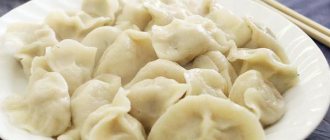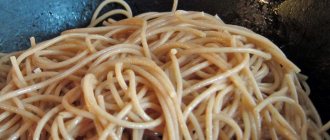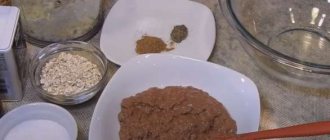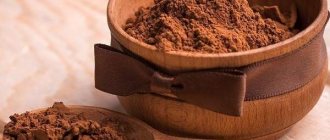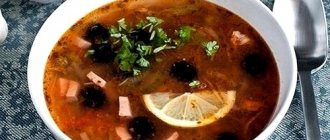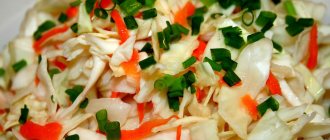Step-by-step preparation
Step 1:
Minced meat can be used both homemade and purchased. Pork, beef, chicken or anything at all. If you, like me, prefer homemade minced meat, then I recommend mincing the meat twice to make it softer. I have minced beef. Cover the minced meat with cling film and leave to rest in the refrigerator for a while.
Step 2:
Pour cold filtered water into a saucepan and place it over medium heat. Do not add salt yet, this will allow the water to boil faster.
Step 3:
Heat sunflower oil in a non-stick frying pan and add finely chopped onions. Fry it over medium heat until golden brown.
Step 4:
Place spaghetti vertically in a boiling pot! water and, as the spaghetti softens, use a spoon to help it completely submerge in the water. Then salt the water to taste.
Step 5:
Cook spaghetti, stirring occasionally, for one minute less than package directions. I simmered mine for six minutes after bringing the water back to a boil. But everyone's spaghetti is different, so follow the instructions. While the spaghetti is cooking, let's make the minced meat.
Step 6:
Place the minced meat in a frying pan and fry, stirring, for about a minute. The minced meat should change its color.
Step 7:
After the excess moisture has evaporated, add tomato paste and salt the dish to taste. You can also add your favorite spices that match the meat.
Step 8:
Simmer the minced meat over low heat, stirring occasionally, for about five minutes.
Step 9:
Ideally, by this time, the spaghetti should already be ready. Drain them in a colander and allow excess water to drain. Then transfer it to the frying pan with the meat.
Step 10:
Gently stir the dish with a spatula so as not to damage the integrity of the spaghetti.
Step 11:
With the lid closed, warm the spaghetti for a couple of minutes. That's why we undercooked the spaghetti in the pan a little. Otherwise, they would have already gone through the frying pan. Spaghetti with minced meat is served hot. You can additionally serve them with tomato sauce and garnish with fresh herbs.
A tasty and satisfying dish for every day. It can be used by adults and even children, if your tomato paste is natural, without preservatives or flavor enhancers.
Adjust the doneness of the spaghetti to your liking. You can leave them al dente and cook until they are as soft as possible. Who likes...
Bon appetit!
The benefits and harms of naval pasta
Navy-style pasta (total calorie content is considered one of the determining factors in the usefulness of a dish) is beneficial for the human body in that:
- high-quality varieties of pasta contain a large amount of fiber (thanks to fiber, the functioning of the gastrointestinal tract is normalized, and accumulated waste and toxins are also removed);
- complex carbohydrates contained in whole grain pasta do not affect blood glucose levels, which makes it possible to include dishes with them in the diet not only of those who are losing weight, but also of those with diabetes (foods that affect blood sugar levels are highly not recommended for consumption by diabetics);
- they increase performance and increase human energy (due to the vitamins, macro and microelements included in the composition);
- they stabilize cholesterol levels;
- significantly reduce the incidence of migraines;
- are the prevention of diseases of the cardiovascular system.
As is the case with other foods and dishes that a person consumes uncontrollably, navy pasta can have a negative impact on health.
Potential harm may include:
- increased glycemic index (when using pasta made from wheat flour in preparing a dish);
- the possible influence of pasta as a flour product on the occurrence of constipation (we are talking about low-quality pasta).
What determines the calorie content of pasta?
It is worth noting that the variation in the calorie content of this product between different manufacturers and different types of pasta can be very large, both in the finished product and in the dry one. What does this depend on? The nutritional value of pasta depends on:
- from the varieties of wheat chosen for production - there are hard and soft varieties;
- from the manufacturer’s recipe - sometimes you can find pasta with various additives;
- from the method of preparing the pasta itself.
Regarding the last point, you need to understand that all additives that are used in pasta when serving a dish can significantly or slightly affect its nutritional value. For example, the most dietary option is to decorate a finished pasta dish with freshly chopped herbs, and if cheese, butter or some sauces are added to the pasta when serving, this increases the nutritional value of the food significantly.
So for those who are watching their figure, it is better to keep control over both the eating of pasta and the form of its preparation and serving.
"Durum" is not for fools
Walking past the grocery department, it’s hard not to get confused: here you will find yellow and colored pasta, thin and thick, and twisted, and horns, in the form of butterflies and shells, plates and spirals. And what names! Not just noodles and vermicelli, but capellini, linguine, fettuccine, bucatili, farfalle, fusilli, rigatoni... However, you can’t list everything. They say that Italians know at least 300 varieties of pasta. But, since the dietary properties of these products are more or less the same, we will not delve into the intricacies.
Then what should you pay attention to when buying? You definitely shouldn’t take the cheapest pasta: they are made from soft wheat varieties, so they have the highest glycemic index and the worst taste. When cooked, they stick together due to the abundance of starch in their composition and look like a grayish porridge. The more expensive the product, the lower the risk that it will be of poor quality, tasteless and unhealthy. But in order not to overpay, you should pay attention to the packaging. Good pasta is the one made from durum wheat. You can also focus on the letter marking: “A”, “B” or “C”. Look for the letter “A” on the package: this is a guarantee that the pasta is made from good raw materials, that is, it contains little starch and a lot of fiber and vitamins. Good pasta has two ingredients: water and flour. However, pasta is sometimes made with healthy additives: seaweed, bran, buckwheat. The product will not lose anything from this, but only gain.
Is it possible to eat pasta while dieting?
Pasta can hardly be called a dietary dish, so if during a diet aimed at weight loss, it is better to exclude it from the diet or minimize it .
However, a small portion of this food (only pasta made from durum wheat) can have a positive effect on the functioning of the intestines and digestive organs, and maintain strength while following a low-calorie diet.
In addition, pasta contains a number of useful substances; it is not “empty calories”, but food with its own advantages. 100 grams of this product made from premium flour (dry) contains:
- proteins – 11 grams;
- fat – 1 gram;
- carbohydrates – 71 grams;
- vitamin PP – 2.90 mg (15% of the daily value);
- vitamin B1 – 0.17 mg (11% of the daily value);
- vitamin B6 – 0.16 mg (8% of the daily value).
And also such useful microelements as magnesium, potassium, phosphorus, sulfur, copper, manganese and much more.
So it’s not necessary to give up pasta during your diet; it’s better to just reduce your consumption a little.
Product calorie analysis
Ratio of proteins, fats and carbohydrates:
- Vitamin B1 is part of the most important enzymes of carbohydrate and energy metabolism, providing the body with energy and plastic substances, as well as the metabolism of branched amino acids. A lack of this vitamin leads to serious disorders of the nervous, digestive and cardiovascular systems.
- Vitamin B12 plays an important role in the metabolism and transformation of amino acids. Folate and vitamin B12 are interconnected vitamins that are involved in hematopoiesis. A lack of vitamin B12 leads to the development of partial or secondary folate deficiency, as well as anemia, leukopenia, and thrombocytopenia.
- Vitamin E has antioxidant properties, is necessary for the functioning of the gonads and heart muscle, and is a universal stabilizer of cell membranes. With vitamin E deficiency, hemolysis of erythrocytes and neurological disorders are observed.
- Vitamin PP is involved in redox reactions of energy metabolism. Insufficient vitamin intake is accompanied by disruption of the normal condition of the skin, gastrointestinal tract and nervous system.
- Calcium is the main component of our bones, acts as a regulator of the nervous system, and is involved in muscle contraction. Calcium deficiency leads to demineralization of the spine, pelvic bones and lower extremities, increasing the risk of developing osteoporosis.
- Phosphorus takes part in many physiological processes, including energy metabolism, regulates acid-base balance, is part of phospholipids, nucleotides and nucleic acids, and is necessary for the mineralization of bones and teeth. Deficiency leads to anorexia, anemia, and rickets.
- Cobalt is part of vitamin B12. Activates enzymes of fatty acid metabolism and folic acid metabolism.
- Copper is part of enzymes that have redox activity and are involved in the metabolism of iron, stimulates the absorption of proteins and carbohydrates. Participates in the processes of providing oxygen to the tissues of the human body. Deficiency is manifested by disturbances in the formation of the cardiovascular system and skeleton, and the development of connective tissue dysplasia.
- Selenium is an essential element of the antioxidant defense system of the human body, has an immunomodulatory effect, and is involved in the regulation of the action of thyroid hormones. Deficiency leads to Kashin-Beck disease (osteoarthritis with multiple deformities of the joints, spine and limbs), Keshan disease (endemic myocardiopathy), and hereditary thrombasthenia.
- Zinc is part of more than 300 enzymes and is involved in the processes of synthesis and breakdown of carbohydrates, proteins, fats, nucleic acids and in the regulation of the expression of a number of genes. Insufficient consumption leads to anemia, secondary immunodeficiency, liver cirrhosis, sexual dysfunction, and the presence of fetal malformations. Research in recent years has revealed the ability of high doses of zinc to disrupt the absorption of copper and thereby contribute to the development of anemia.
more hide You can see a complete directory of the healthiest foods in the “My Healthy Diet” app.
This section presents the calorie content of pasta with minced meat in various cooking options, as well as the content of proteins, fats and carbohydrates. All data is provided per 100 grams of the finished product. To find out the content of BZHUK in a serving (plate), enter the required amount of product into the calculator.
1 standard serving of food (plate) = 250 grams.
I want more!
Now about the main thing. What to add to pasta to make it a complete dish? After all, few people want to eat empty pasta. But don’t rush to grab a grater to grate your favorite fatty cheese into spaghetti and put away ketchup and cream, and even more so mayonnaise. We definitely won't need them. As well as fried meat, fatty minced meat or - especially - sausage and bacon. Combining these products with each other is tasty and satisfying, but your figure will definitely not appreciate it. And the body, by the way, too.
To make pasta a dietary dish, you can mix it with vegetables (any except starchy ones: potatoes, beets, pumpkins, carrots). They also make a good combination with lean fish, mushrooms, seafood, herbs and low-fat cheeses (ricotta, tofu, feta cheese, curd cheeses). If you really want meat, you can add a small amount of lean poultry (chicken or turkey breast, steamed or grilled). As a sauce, you can use olive oil with lemon juice and mustard, balsamic vinegar, natural yogurt with garlic and tomato paste. But a little bit of everything. And, of course, it is important to remember the serving size (about the size of your palm), and also that pasta dishes are consumed for breakfast or lunch, and not for dinner.
What is the calorie content of noodles per 100 g, what is the calorie content of spaghetti per 100 g?
100 g of spaghetti contains approximately 340 calories and about 1 g of fat. Having a fairly high energy value, the finished dish can provide 9% of the daily calorie intake that an adult needs.
At the same time, depending on the recipe you choose, the calorie content of this pasta may vary. For example, 100 g of bolognese will contain about 200 calories. But spaghetti with seafood will have half the calories.
It is important to remember that thin, compressed spaghetti has a GI ten points lower than similar thick pasta.
Also, it is worth noting another type of pasta, namely noodles . The calorie content of noodles per 100 g is about 320 calories. This pasta product is perhaps the most common in popular world cuisines. Quite often, noodles are prepared from various types of flour at home. At the same time, noodles, which are prepared from pea flour or from durum flour, are considered the lowest in calories. In this case, ready-made boiled noodles not only do not harm the body, but help with dysbacteriosis and restore the intestinal microflora.
But buckwheat noodles are considered the most dietary, with a calorie content of 160 calories per 100-gram serving of the product!
How many calories are in 100 grams of pasta?
Pasta is not only tasty, but also a healthy product. Due to the content of vitamin B in products made from durum wheat, a person feels a surge of strength and energy for a long time. Amino acids help normalize sleep and mood, and fiber helps remove all harmful substances from the body and restores intestinal function.
The Italian product differs from the domestic one in composition. In the first case, only flour and water are used, in the second, eggs and butter are added.
Flour for making pasta can be of baking, hard, or glassy varieties. The first option is considered more beneficial for the body. Depending on the type, the calorie content of the product (dry) is 320-360 kcal. About the same numbers for or.
For your diet, it is better to choose products made from rice or buckwheat flour.
The products of the well-known brand “Makfa” (only durum wheat is used) have 345 kcal, the products do not become overcooked and keep their shape. Barilla has a higher figure - 360 kcal. Spaghetti, bows, lasagna sheets, feathers are distinguished by their excellent taste and high quality. Manufacturers can add tomatoes, spinach, carrots, spices and herbs to create beautiful and more savory pasta.
How are calories in navy pasta calculated?
In an uncooked state, pasta contains approximately 350 kcal per 100 grams, and after cooking it decreases to 130-160, since the product more than doubles in volume.
If butter is added to the recipe with minced meat, the calorie content of the pasta will increase significantly, but you will get a complete dish, filled with numerous useful substances and energy.
- What can you replace mayonnaise with?
- How to cook green radish?
To calculate the calorie content of naval pasta, you need to take into account the method of its preparation, or rather the ingredients used:
- Navy pasta with minced chicken has a calorie content of 130 to 145 kcal;
- a dish with turkey contains up to 190 kcal;
- in navy pasta with minced beef, the calorie content is about 280 kcal;
- calorie content of navy-style pasta with lean pork is approximately 290 kcal;
- calorie content of pasta with stewed meat is from 250 to 350 kcal.
Calorie content of boiled and fried pasta
The energy value of pasta depends not only on its type, but also on the products that are added during the cooking process. When cooking, the numbers decrease by more than 2 times (about 120 kcal per 100 grams). This is due to the increase in volume of products after boiling.
One standard serving of boiled pasta (150 g) contains 180 kcal.
Additives (butter, sauces, cheese, sour cream) significantly change the value of the finished dish. For boiled products with butter (2 tablespoons), the indicator will be almost 180 kcal per 100 g. Read about the properties and calorie content of butter.
Nutritionists advise replacing animal oil with vegetable oil. In the homeland of pasta, olive oil is used; when it is added, the energy value is reduced by 20 units (160 kcal). Get to know us in our article. If you want to fry pasta in oil, you should pay attention to the high calorie content of the finished dish - more than 190 kcal.



